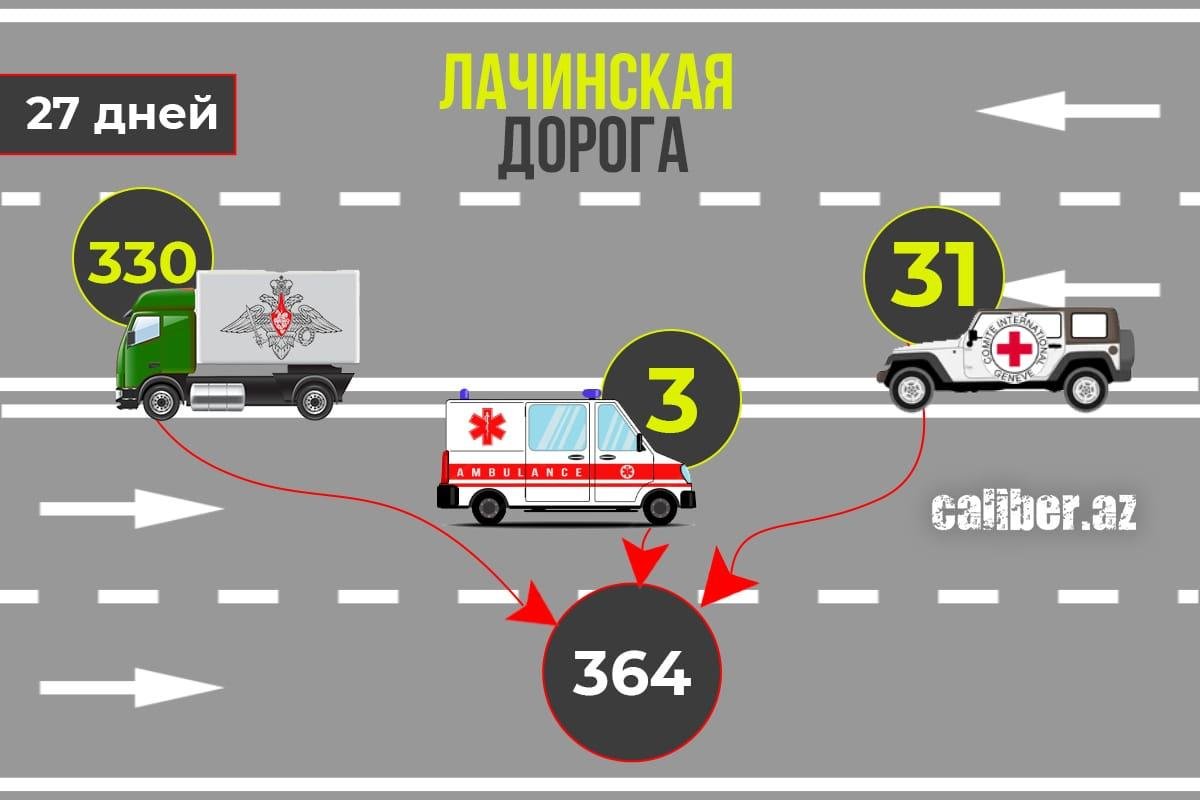Vardanyan unwittingly turns the cards over on "mass hunger" in Karabakh The show won't go on
Unhindered delivery of food and other goods from the territory of Armenia to Khankendi in the required volumes continues as usual along the Lachin road, where the action of Azerbaijani eco-activists is taking place.
According to Caliber.Az, 370 various purpose vehicles freely moved in both directions of Lachin-Khankendi road from December 12, 2022, to January 5, 2023. They included 330 vehicles of the Russian peacekeeping contingent, 31 ambulances belonging to the International Committee of the Red Cross, and 3 belonging to local Armenians.
We will try to find out how much food was delivered to the region by 330 vehicles of the Russian peacekeeping contingent. First, let's pay attention to the number and volume of transportation by vehicles of the Russian peacekeeping contingent.
From December 12 of last year till January 5 of this year, 40 KAMAZ trucks and 15 URAL trucks of the Russian peacekeeping contingent were used to deliver foodstuffs to Khankendi. During inspections, it was found that the trucks were carrying large quantities of rice, canned meat, pasta, flour, potatoes, onions, chicken, vegetables, cabbage, sugar, and coffee.
Most of the Russian peacekeeping contingent's trucks are KAMAZ-5350, each able to carry a load of 8 tonnes. At the same time, the Russian peacekeeping contingent's fleet of URAL 4320 trucks has a load capacity of 6 tonnes.

Therefore, with 40 KAMAZ trucks (40*8=320) and 15 URALs (15*6=90), 410 tonnes have been transported. The 2,000 Russian peacekeepers deployed in the zone consume 130 tonnes of food per month. That is, 2.2 kg of foodstuffs per peacekeeper per day. This is twice as much as the world's food basket.
The superior limit of food ration may reach 50 tons, taking into account the consumption of 4 tons of rice, 3 tons of pasta, 1.5 tons of canned meat, 4 tons of buckwheat, 1 ton of flour, 10 tons of cabbage, 5 tons of onions, 30 tons of potatoes and other products and drinks. The cargo-carrying capacity of the 55 trucks of the peacekeeping contingent is 410 tonnes. That is, in the aforementioned period they have delivered 6 or 7 times the number of foodstuffs that they consume in a month. This indicates that these food items have been delivered to Khankendi and nearby localities. Earlier, in October-November, trucks had not transported such quantities. This fact suggests that the peacekeeping contingent has delivered foodstuffs for 15-20 thousand people in the last month. Pay attention to the last figures.
Let us try to determine the food supply based on the carrying capacity of the remaining 330 vehicles for various purposes. Even if these vehicles are designed to carry passengers, they have at least 700 kg of luggage capacity.
Among these vehicles are large Ford models, Gazelles, and others, each with a capacity of up to 1.5 tonnes. Taking the minimum payload into account, 200 of the 330 vehicles have a capacity of 700 kg and the remaining 130 have a capacity of 1,500 kg. Taken together, the vehicles can transport an average of 335 tonnes (200*700kg = 140 tonnes +130*1500kg = 195 tonnes). At least 230 tons of foodstuffs a month can provide enough food for 15 thousand of people.
Therefore, the total volume of 410 tons delivered in 55 vehicles of the Russian peacekeeping contingent and 330 other vehicles is 740 tons. Subtracting 50-60 tonnes from this figure to meet the needs of the peacekeepers leaves more than 680 tonnes. This amount could satisfy the food requirements of the population of Khankendi and nearby villages for at least 20 days. Again, these figures are for 15-20,000 people.
Let's pay attention to other facts.
One of the leaders of the Karabakh separatists, Ruben Vardanyan, told the Armenian media that patients from Khankendi are brought to Armenia through the International Committee of the Red Cross, while at the same time, they receive food from Russian peacekeepers. Here is his quote: "We have grain, meat, and milk in a small volume. There are no other products anymore."
In addition, David Ananyan, "head of the community" in the village of Shen in the Agdara region, previously stated that they had run out of fruit, but that potatoes were available.
The "head of the Armenian community" of Khojaly, Boris Gahramanyan, stated in an interview with Armenian media that despite half-empty shop shelves, they have no shortage of bread.
Based on the above statements, we can conclude that the region has grain, bread, potatoes, meat, and milk reserves. If we include the 680 tonnes of food delivered in the last month, the region has significant food stocks. This circumstance, in turn, makes the statements about the threat of mass starvation groundless.
Thus, there is no problem in supplying the population of Khankendi and the surrounding settlements with food, medicines, and other goods.
Statements by the Armenian authorities and Vardanyan that they "have been under blockade for 24 days", "we have run out of food supplies", "famine prevails" and so on are nothing more than lies and yet another show to mislead the international public.
The most important thing here is that we have once again seen that the number of Armenians living in the Karabakh economic region is exaggerated. The food supplies delivered to the region are meant to provide for 15-20,000 Armenians, not 120,000.








